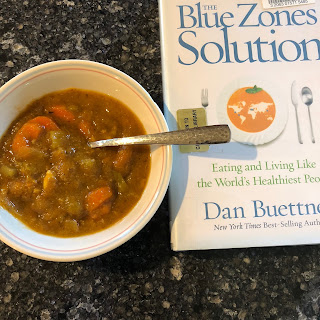Do I post this with my 52 Books in 52 Weeks Challenge type of posts or with my siblings blog on health? The competitive side of me (not that 52 in 52 is a competition...haha) won out, but I will copy this into our family health blog as well (found here).
Photography is not my strength so apologies ahead of time. This mushroom soup is actually excellent. It did not come from the recipes in The Blue Zones Solution but I have been inspired by Dan Buettner's research into the Blue Zones ever since I first read his articles for National Geographic.
This book goes beyond those National Geographic articles which covered how people in Blue Zones ate and lived. Blue Zones are those areas of the world where the most centenarians live. In The Blue Zones Solution, Buettner revisits those zones in Greece, Japan, Italy, Costa Rica, and, yes, even the United States. In Part Two of the book, his team learned from Finland how to teach three areas of the United States how to create their own Blue Zones. In Part Three, Buettner discusses making a Blue Zone a personal choice, followed by Part Four, the recipes.
Since I've been reading a number of other health books with food protocols in them (Genius Foods, The End of Alzheimer's, and The Plant Paradox), I had comparisons to make. There are some situations that most writing healing food books seem to agree upon: the Standard American Diet is SAD, not just an acronym, but truly 😢, and sugar is not good for us. (See my post on that here.)
However, there are some differences. Legumes. Centenarians eat them, no question about that. And, they do eat bread, just not ones with the kind of grains in the typical SAD meal plan. Legumes and grains are not high on the list of some of these other protocols. That being said, the books previously mentioned are fighting back against some specific diseases (Alzheimer's, inflammations of many types).
I find reading a combination of these healing food protocols and paying attention to one's own body and medical tests are a good start to finding a healing protocol designed for oneself.
The Blue Zones Solution also addresses lifestyles of centenarians, not just healing foods, but a thriving lifestyle, this and the recipes make the book worth buying.
Buettner's Mushroom Stew includes white wine, soy sauce, and rice -- all of which are not healing for my Celiac's, thyroid, sky high iron, or potential for Alzheimer's so I offer my version which I made the day before yesterday and thought tasted quite good! It made just two servings (1 for the day before and 1 for yesterday).
Deborah's AIP (Autoimmune Protocol) Mushroom Soup
(I use food that has not been sprayed with chemicals, etc.: truly organic in practice, not just on the label)
In a saucepan, cover the following with water:
2 small stalks of celery, sliced thin (I included the leafy parts which I took out before eating)
2 carrots, sliced thin
3 cloves of garlic, chopped or diced
5-6 dried shiitake mushrooms
1/2 onion, diced
I simmered this until the vegetables were soft. The dried mushrooms remained a bit chewy when I was ready to eat so when I...
Blend about 3 ladles and include all of the mushrooms until smooth. NOTE: I learned to hold a towel over the top of the blender when I blend something hot. This is supposed to prevent the top from flying off from the heat. I have not had any flying top disasters.
Put the blended soup into the rest of the soup and simmer to thicken it up. I started grabbing spices, salt, and pepper which I thought were AIP (I didn't double check.) I just dashed them in. Mediterranean salt, pepper, curry, turmeric, and dill weed.
💕💕💕💕💕💕💕💕💕💕💕💕💕💕💕💕💕💕💕💕💕💕💕💕💕💕💕💕💕
Blue Zone ideas for raising children: Besides being mindful about what one eats, having an optimal circadian rhythm for sleep and bedrooms that are cool, quiet, and dark, are beneficial for health. Working in the yard, planting a garden all practices for thriving. Creating a group of mutually committed friends, not just at a stage of life, but people with whom you will be young with and grow old with, is something that people do who live in Blue Zones.
--------------------------------------------------------------------------------------------------------------------
Interesting that a spiritual practice is fasting. It turns out that almost every healing protocol involves a form of fasting. NOT starving as in harmful practices. But, practices such as making one's last meal of the day be at least 3 hours before bedtime. In today's fast paced busy world, we're often grabbing food at 9 pm and then sending the children to bed. The Creator who made our bodies apparently knows our bodies need to relax at a meal and then give our bodies time to digest it before heading off into some good sleep.


